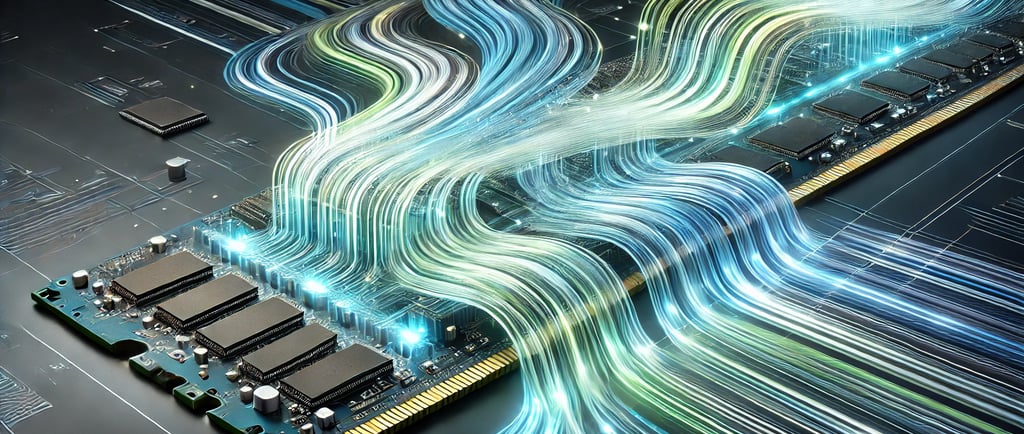Memory Latency's Impact on Compute Performance
Memory Matters #13


Memory latency—the delay experienced when data is fetched or stored—is increasingly becoming a critical factor in system performance. Despite impressive advancements in processor speeds, memory access times haven't kept pace, creating a widening gap commonly known as the "memory wall." As processors have grown faster and more powerful, this latency issue has evolved into one of the most significant bottlenecks limiting overall computational efficiency.
Why Memory Latency Matters
Memory latency directly affects system efficiency by causing processors to idle while awaiting data retrieval. Even brief delays, when multiplied across countless data requests, accumulate into significant performance degradation. In gaming, for instance, elevated latency results in noticeable frame drops or stuttering, undermining smooth gameplay and responsiveness. Machine learning workloads similarly suffer, as higher latencies slow data retrieval during model training, inflating training durations and slowing experimentation cycles. For large-scale data processing tasks like video editing or scientific computations, latency directly translates into extended rendering or computation times.
Beyond just performance impacts, memory latency also has notable implications for energy efficiency. When a CPU stalls due to delays in data retrieval, energy consumption increases unnecessarily, leading to higher power demands. In battery-constrained devices such as smartphones and laptops, this translates directly into shorter battery life and poorer user experience. Within data centers, latency-induced processor idling significantly raises energy consumption, leading to higher operational costs and environmental impacts.
Several factors contribute to memory latency. Firstly, memory technology itself plays a crucial role. Newer standards, such as DDR5 or High Bandwidth Memory (HBM), deliver higher data transfer speeds compared to DDR4, but still face intrinsic latency constraints linked to internal timings and architecture. Secondly, the overall system architecture—including cache hierarchies, CPU-memory interconnects, and memory channel configurations—can either mitigate or exacerbate latency. Efficient cache structures reduce the frequency of slow main-memory accesses, significantly improving performance. Furthermore, the number and arrangement of memory channels influence the degree of parallelism achievable, affecting how effectively latency can be masked.
Workload patterns also strongly influence the experience of latency. Applications with sequential data access patterns benefit significantly from prefetching and caching techniques, reducing latency by proactively loading anticipated data into faster memory tiers. Conversely, workloads with random or scattered memory accesses, such as graph databases or complex analytics, frequently encounter cache misses and thus experience higher latency. Large datasets often exacerbate latency issues, as data size surpasses cache capacity, causing frequent cache evictions and slower main memory fetches.
To mitigate memory latency, industry experts and researchers are pursuing diverse optimization strategies:
Cache Optimization: Enhancing multi-level cache designs (L1, L2, L3) and employing prefetching algorithms to anticipate data requests can significantly lower effective latency. Proper sizing and associativity of caches ensure efficient data retrieval and fewer cache misses.
Memory Interleaving and Bank-Level Parallelism: Distributing data across multiple banks or channels enables parallel memory accesses, masking individual bank delays. Optimized scheduling algorithms in memory controllers further improve efficiency by reducing conflicts and maximizing parallel data retrieval.
Memory Compression: By compressing data before storing it in memory, systems decrease the volume of data transferred, effectively reducing latency and bandwidth usage. However, compression introduces computational overhead, making it most effective when bandwidth constraints outweigh the additional processing cost.
Processing-In-Memory (PIM): Integrating computational capabilities into memory modules directly reduces latency by minimizing data transfers between memory and processors. PIM architectures excel in data-heavy tasks, such as matrix computations, graph processing, and AI workloads.
Software and Compiler Techniques: Compiler-level optimizations like data layout restructuring and loop blocking or tiling enhance cache locality, reducing unnecessary memory fetches. Advanced, AI-driven compilers can dynamically adapt code structures and memory access patterns, continuously optimizing for minimal latency.
Addressing memory latency is essential as we advance into a future dominated by data-intensive applications. Innovations such as Processing-in-Memory architectures, optimized memory standards, and intelligent software solutions will be critical for overcoming the latency barrier. By embracing a multifaceted optimization strategy that combines hardware advancements, intelligent software techniques, and tailored architectural design, the computing industry can significantly alleviate memory latency challenges, unlocking unprecedented levels of performance and efficiency.
Linked to ObjectiveMind.ai
